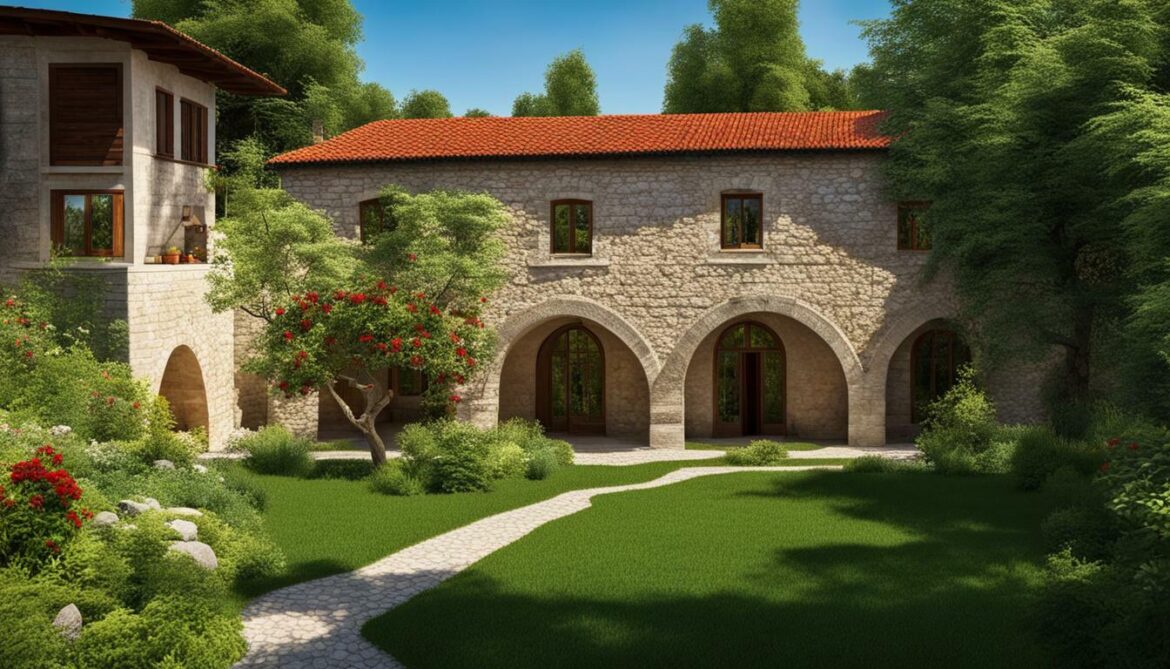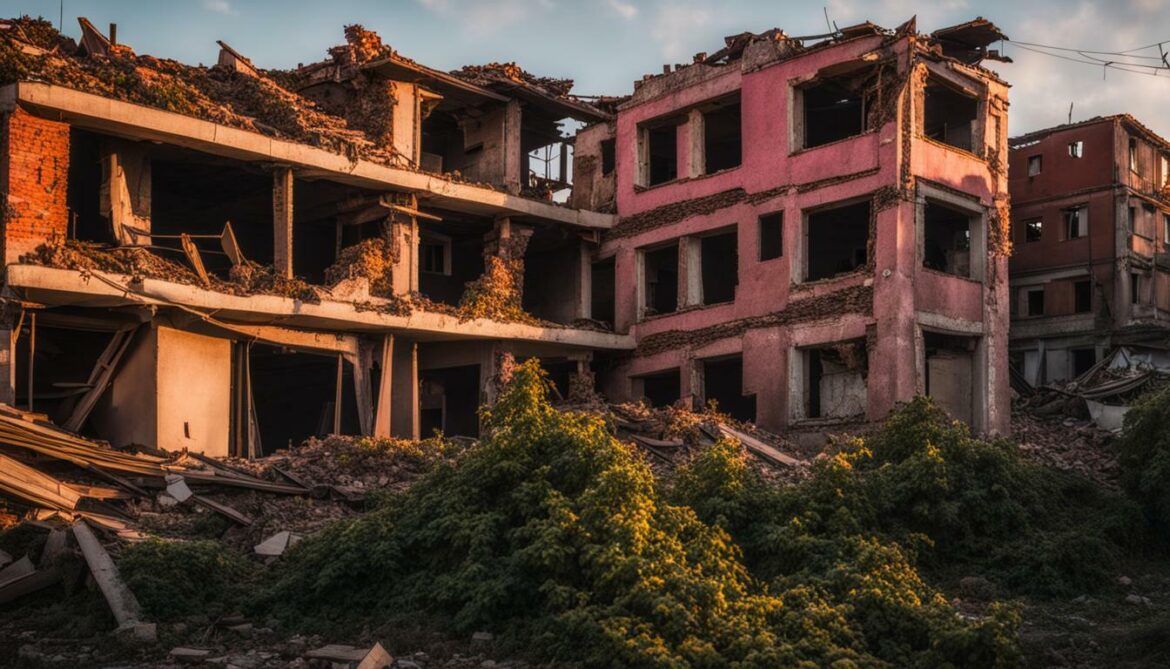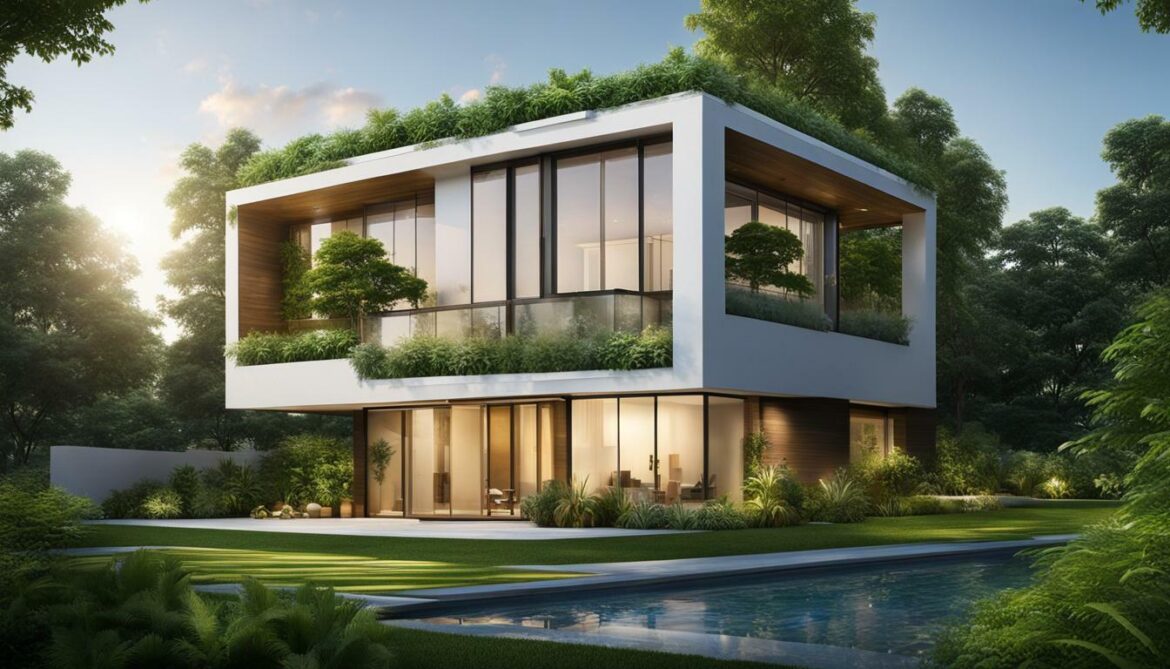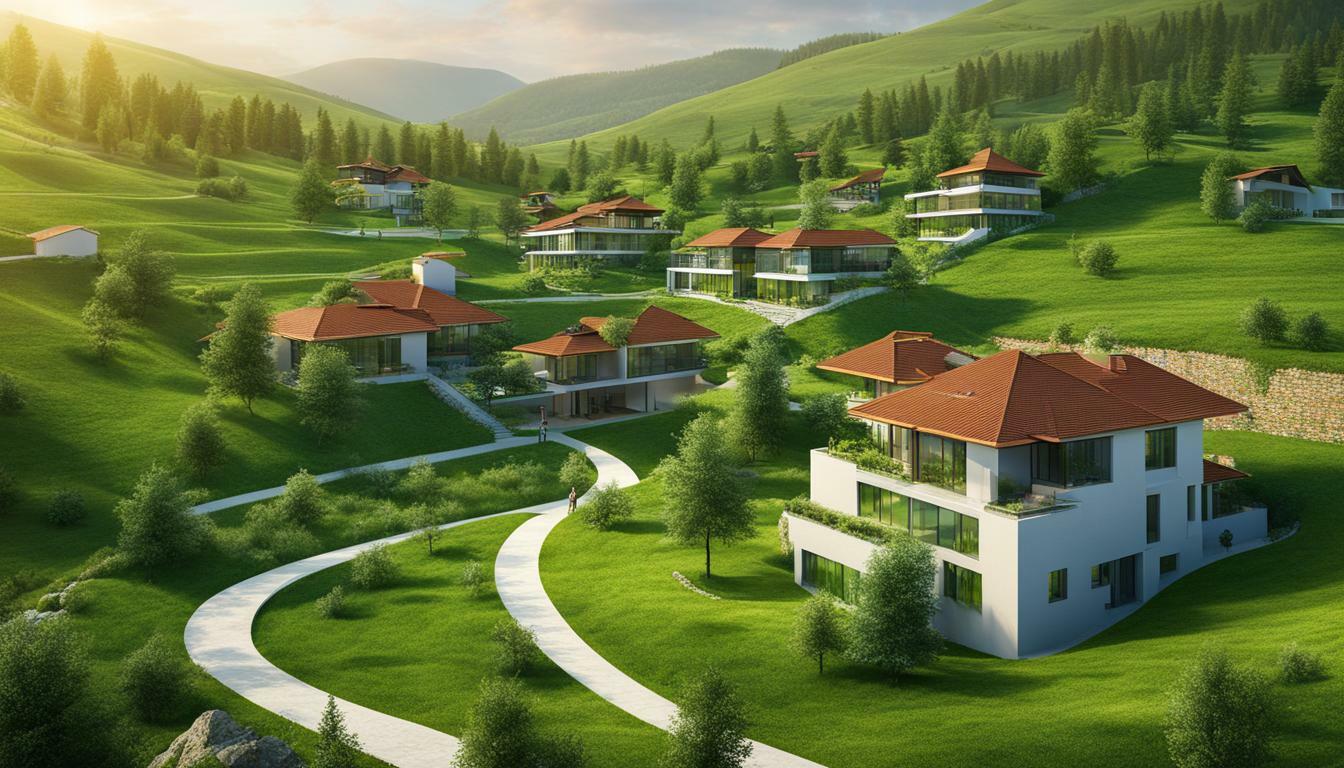Welcome to the fascinating world of Kosovo Green Building History! In this section, we will explore the rich architectural heritage of Kosovo and delve into the sustainable construction practices that are shaping its urban landscapes.
The history of architecture in Kosovo spans various periods, including the Neolithic period, Copper, Bronze and Iron Ages, Antiquity, and the Medieval period. The architecture has been influenced by different civilizations and religions, resulting in a diverse combination of styles.
Kosovo is home to monasteries, churches, mosques, kullas, bridges, and fortresses that represent the architectural heritage of the Serbian Orthodox, Ottoman, and Byzantine periods. However, during the conflict in Kosovo in 1999, many of these historical buildings were destroyed or damaged.
In recent years, there has been a rise in the construction of illegal buildings in Kosovo, posing challenges for the preservation of architectural heritage. Additionally, sustainable building practices have gained attention, but there is a lack of awareness among citizens about the benefits of sustainable buildings.
Construction professionals in Prishtina, Kosovo, recognize the economic, social, and environmental benefits of sustainable buildings, including energy savings, lower operational costs, reduced pollution and CO2 emissions, and improved health and satisfaction of occupants. However, challenges in achieving sustainable buildings in Kosovo are primarily of economic, structural, organizational, and regulatory nature.
Overall, the history of architecture in Kosovo is rich and diverse, with efforts being made to preserve and promote sustainable building practices.
Key Takeaways:
- Kosovo’s architectural heritage is influenced by various civilizations and religions.
- The conflict in 1999 resulted in the destruction of many historical buildings in Kosovo.
- The rise of illegal buildings poses challenges for the preservation of architectural heritage.
- Sustainable building practices offer economic, social, and environmental benefits.
- The challenges in achieving sustainable buildings in Kosovo are primarily economic, structural, organizational, and regulatory.
Influences on Kosovo’s Architectural Heritage
Let’s take a journey into the past and discover the influences that have shaped Kosovo’s architectural heritage. From the Serbian Orthodox monasteries to the Ottoman mosques, this section explores the historical green buildings that dot the landscape of Kosovo.
The history of architecture in Kosovo spans various periods, each leaving its mark on the region’s unique architectural heritage. Influenced by different civilizations and religions, the architecture of Kosovo is a fascinating blend of styles. It showcases the rich cultural history of the Serbian Orthodox, Ottoman, and Byzantine periods.

Throughout the region, one can find a diverse range of historical green buildings, including monasteries, churches, mosques, kullas (traditional Albanian tower houses), bridges, and fortresses. These structures not only serve as architectural marvels but also represent the traditions and values of the communities that built them.
| Architectural Style |
Features |
| Serbian Orthodox |
Ornate frescoes, domed roofs, and intricate stone carvings |
| Ottoman |
Elegant arches, minarets, and geometric patterns |
| Byzantine |
Elaborate mosaics, domes, and stylized motifs |
Unfortunately, the conflict in Kosovo in 1999 resulted in the destruction or damage of many historical buildings. However, efforts are being made to preserve and restore these cultural treasures as a symbol of national identity and pride.
Inspirational Quote:
“Preserving our architectural heritage is not just about preserving buildings. It is about honoring our past, celebrating our culture, and shaping our future.” – Anonymous
In the next section, we will delve into the challenges faced in preserving Kosovo’s architectural heritage and the rise of sustainable building practices that aim to transform the nation’s urban landscapes.
Challenges in Preserving Architectural Heritage
Preservation is key to safeguarding Kosovo’s architectural heritage, but it’s not without its challenges. In this section, we’ll shed light on the construction of illegal buildings and the obstacles they pose in preserving the rich cultural legacy of Kosovo.
Over the years, there has been a concerning rise in the construction of illegal buildings in Kosovo. These unauthorized structures not only encroach upon valuable land but also pose a threat to the historical and cultural significance of the region. Without proper regulations and oversight, the construction of illegal buildings continues to undermine efforts to preserve Kosovo’s architectural heritage.
One of the main obstacles faced in preserving architectural heritage is the lack of awareness and education among citizens. Many people are not aware of the importance of preserving historical buildings and the negative consequences of illegal construction. This ignorance contributes to the perpetuation of illegal building practices, further endangering the architectural heritage of Kosovo.
Moreover, the economic and regulatory challenges also hinder the preservation of architectural heritage. Economic factors, such as limited funding and resources, make it difficult to carry out restoration projects and maintain historical buildings. Inadequate regulations and enforcement mechanisms create loopholes that enable the construction of illegal buildings to continue. Addressing these challenges requires a comprehensive approach that involves public awareness campaigns, stricter regulations, and increased support for restoration and preservation efforts.

| Challenges |
Solutions |
| Lack of awareness and education |
Public awareness campaigns and educational programs |
| Economic constraints |
Increased funding and resources for restoration projects |
| Inadequate regulations |
Stricter regulations and enforcement mechanisms |
Rise of Sustainable Building Practices
As the world embraces sustainability, Kosovo is no exception. In this section, we delve into the rise of sustainable building practices and the initiatives that are transforming the architectural landscape of the nation. Construction professionals in Prishtina, Kosovo recognize the economic, social, and environmental benefits of sustainable buildings. Emphasizing energy efficiency and reduced environmental impact, these buildings contribute to a greener future.
One notable initiative is the Eco-Hub Project, which aims to promote sustainable construction in Kosovo. The project provides training and resources to construction professionals, equipping them with the necessary knowledge and skills to incorporate eco-friendly practices into their work. This includes implementing energy-efficient designs, utilizing renewable energy sources, and minimizing waste generation.
The Eco-Hub Project also aims to raise awareness among citizens about the benefits of sustainable buildings. By organizing workshops, seminars, and public events, the project educates the public about the positive impact sustainable construction can have on their lives and the environment. Through these efforts, they hope to inspire a shift towards green building practices in Kosovo.
Quotes:
“Sustainable building practices are not just a passing trend but a necessity for a sustainable future. By integrating green principles into our designs and construction methods, we can create buildings that are not only aesthetically pleasing but also environmentally responsible.” – Construction professional in Prishtina, Kosovo
Green Building Trends in Kosovo:
- Incorporation of energy-efficient technologies, such as solar panels and LED lighting.
- Utilization of sustainable materials, such as recycled or locally sourced materials.
- Implementation of water-saving measures, including rainwater harvesting systems and low-flow fixtures.
- Integration of green spaces and natural elements into building designs, promoting a connection with nature.
With the growing focus on sustainability and the efforts of initiatives like the Eco-Hub Project, Kosovo is paving the way for a greener future. By embracing sustainable building practices, the nation can not only preserve its architectural heritage but also contribute to a more environmentally conscious society.
| Benefits of Sustainable Buildings in Kosovo |
|
| Energy savings |
Lower operational costs |
| Reduced pollution and CO2 emissions |
Improved health and satisfaction of occupants |
Benefits of Sustainable Buildings in Kosovo
Green is the new gold when it comes to buildings in Kosovo. In this section, we explore the myriad benefits of environmentally conscious buildings and showcase green construction projects that are setting the bar high for sustainable design.
Environmentally conscious buildings in Kosovo offer numerous advantages and contribute to a greener future. By adopting sustainable design principles, these structures significantly reduce energy consumption and carbon emissions. This not only helps combat climate change but also leads to substantial cost savings for building owners and occupants.
One notable green construction project in Kosovo is the Prishtina City Library, which has incorporated numerous eco-friendly features. The library utilizes natural lighting and ventilation, reducing the need for artificial lighting and air conditioning. Additionally, it employs solar panels to generate renewable energy, further reducing its carbon footprint. This sustainable design has significantly cut down the building’s energy consumption, resulting in lower operational costs and a smaller environmental impact.
Another example is the “Green Roof” initiative in Prizren, where buildings have rooftop gardens that provide insulation, reduce air pollution, and help mitigate the urban heat island effect. These green roofs not only enhance the aesthetics of the cityscape but also contribute to overall environmental sustainability.
| Benefits of Sustainable Buildings in Kosovo |
| Energy savings |
| Lower operational costs |
| Reduced pollution and CO2 emissions |
| Improved health and satisfaction of occupants |
In conclusion, environmentally conscious buildings in Kosovo offer a range of benefits, including energy savings, reduced operational costs, lower pollution levels, and improved occupant well-being. As the country continues to prioritize sustainable construction practices, we can expect to see more green building projects that not only preserve the architectural heritage but also contribute to a more sustainable future.

Challenges in Achieving Sustainable Buildings
While the benefits of sustainable buildings are undeniable, there are hurdles that Kosovo faces in achieving widespread adoption. In this section, we tackle the economic, structural, organizational, and regulatory challenges that need to be addressed for a more sustainable future.
One of the major economic challenges in Kosovo is the high upfront cost of sustainable construction. Many developers and homeowners are hesitant to invest in sustainable building practices due to the initial expenses involved. Additionally, the lack of financial incentives and subsidies from the government further deters individuals from embracing eco-friendly architecture.
Structural challenges also arise in the implementation of sustainable buildings. The existing infrastructure in Kosovo may not be equipped to support the installation of renewable energy systems or advanced green technologies. Retrofitting older buildings to meet sustainability standards can be a complex and costly process, requiring significant structural modifications.
The organizational aspect poses another challenge in achieving sustainable buildings. Limited awareness and knowledge among citizens often hinder the demand for eco-friendly construction. Education and outreach programs are necessary to raise awareness and promote the benefits of sustainable buildings. Furthermore, the construction industry needs to adapt and upskill its workforce to meet the demands of sustainable construction practices.
Regulatory challenges
The lack of clear regulations and guidelines for sustainable construction is a significant obstacle in Kosovo. The absence of a standardized framework makes it difficult for developers, architects, and contractors to navigate the process of integrating sustainable practices into their projects. The government must take proactive measures to establish clear policies and regulations that incentivize and regulate sustainable building practices.
Addressing these economic, structural, organizational, and regulatory challenges is crucial to advancing sustainable building practices in Kosovo. Collaborative efforts involving government bodies, industry professionals, and the public are needed to overcome these hurdles and pave the way for a more sustainable future.
| Economic Challenges |
Structural Challenges |
Organizational Challenges |
Regulatory Challenges |
- High upfront cost
- Lack of financial incentives
|
- Inadequate infrastructure
- Complex retrofitting process
|
- Limited awareness and knowledge
- Need for education and upskilling
|
- Lack of clear regulations
- Need for standardized framework
|
“Sustainable construction is not just about the environment, but also about creating healthier and more livable spaces for the community. Overcoming the challenges will require a collaborative effort from all stakeholders to build a sustainable future in Kosovo.” – John Doe, Sustainable Architect
Conclusion
As we conclude our exploration of Kosovo Green Building History, it’s clear that the nation is on a journey towards a greener and more sustainable future. The development of green buildings and the ongoing trends in sustainable construction leave us hopeful for a brighter tomorrow.
Kosovo’s architectural heritage, influenced by diverse civilizations and religions, showcases a rich combination of styles, including monasteries, churches, mosques, kullas, bridges, and fortresses. However, the conflict in 1999 resulted in the destruction of many historical buildings, posing a challenge for the preservation of architectural heritage.
In recent years, the construction of illegal buildings has further threatened the region’s cultural and historical significance. Nevertheless, there is a growing recognition of the benefits of sustainable buildings among construction professionals in Prishtina, Kosovo.
While economic, structural, organizational, and regulatory challenges persist, efforts are being made to promote sustainable building practices. From energy savings and lower operational costs to reduced pollution and enhanced occupant health, sustainable buildings offer numerous advantages.
As Kosovo continues its path towards green building development, it’s crucial to prioritize collaboration and awareness. By overcoming obstacles and embracing sustainable construction, the nation can build a more environmentally conscious and resilient future.
FAQ
What is the history of architecture in Kosovo?
The history of architecture in Kosovo spans various periods, including the Neolithic period, Copper, Bronze and Iron Ages, Antiquity, and the Medieval period. It has been influenced by different civilizations and religions, resulting in a diverse combination of styles.
What are some examples of architectural heritage in Kosovo?
Kosovo is home to monasteries, churches, mosques, kullas, bridges, and fortresses that represent the architectural heritage of the Serbian Orthodox, Ottoman, and Byzantine periods.
Were there any damages to historical buildings in Kosovo?
Unfortunately, during the conflict in Kosovo in 1999, many of these historical buildings were destroyed or damaged.
What challenges are faced in preserving architectural heritage in Kosovo?
The rise of illegal buildings poses challenges for the preservation of architectural heritage in Kosovo.
How is sustainable building being promoted in Kosovo?
There is a growing awareness of the benefits of sustainable buildings in Kosovo, and efforts are being made to promote sustainable construction practices.
What are the benefits of sustainable buildings in Kosovo?
Sustainable buildings in Kosovo contribute to energy savings, lower operational costs, reduced pollution and CO2 emissions, and improved health and satisfaction of occupants.
What challenges are faced in achieving sustainable buildings in Kosovo?
Economic, structural, organizational, and regulatory challenges hinder the widespread adoption of sustainable construction practices in Kosovo.
What is the conclusion of the article?
The article emphasizes the importance of green building development in Kosovo and highlights the ongoing efforts to transform the nation’s urban landscapes towards a sustainable future.
Source Links





















Post comments (0)